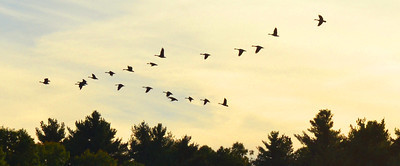How do birds survive such long journeys?
The journeys that migrating birds take can cover enormous distances. The ruby-throated hummingbird travels non-stop for 24 hours across 965km of open ocean from the US Gulf Coast to the Yucatan Peninsula in Mexico, yet only weighs 4.8g! Bar-tailed godwits fly 11,000km (one did this non-stop!) from Alaska to New Zealand.
Birds that migrate have developed special adaptations to help them survive such long journeys. Most migratory birds have hollow bones which make them lighter and therefore better at flying up high in the winds to help carry them along. Some birds develop larger, more powerful breast muscles for flying and have smaller non- essential organs to lighten the load! Many fly in the prevailing winds or thermals (warm air spirals) to help gain distance and height. Geese fly in a ‘V’ shape, changing the leader at the front regularly, to reduce drag. They fly in each other’s slipstream so it’s not such hard work.
Birds also change their feeding behaviours to help them prepare for migration. Most will build up extra fat reserves in the weeks leading up to the long journey (some double their body weight) so they have spare ‘food’ as many don’t eat during migration. Many migratory birds travel in large numbers so they are safer from predators. Stop-offs (short breaks) en route for a rest are common.
Photo: Ashok Boghani

